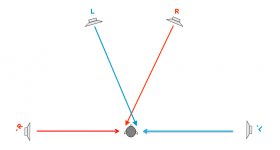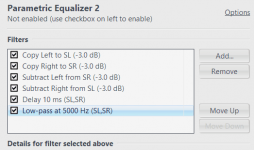Hi there,
This is actually a spinoff from this. It's already OT in that thread, so I think I'd better start a new one.
Many of you must have quite a few unused equipment collecting dust in the storage. Why not bring them back and have some fun?
In the link above, that is a '70 Hafler circuit. Outer channels play differential signals:
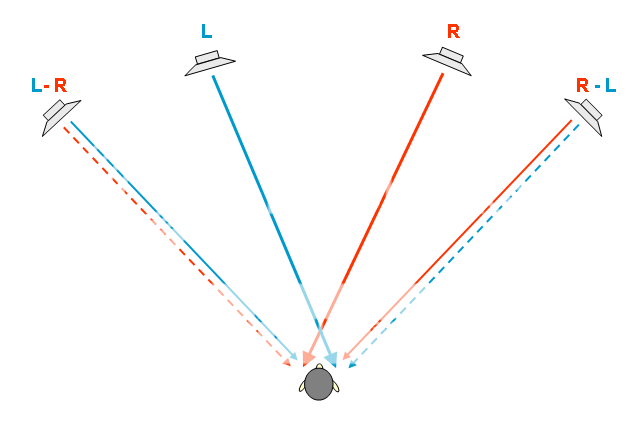
As can be seen, there's -R portion at the far L; -L portion at the far R. What's this? It's cross-talk cancellation !! Wow !
Also, there're (duplicated) R & L at the outside, which may expand the stage width (pro), but can also smear the images (con).
With the same physical layout and rewiring, they can do this:
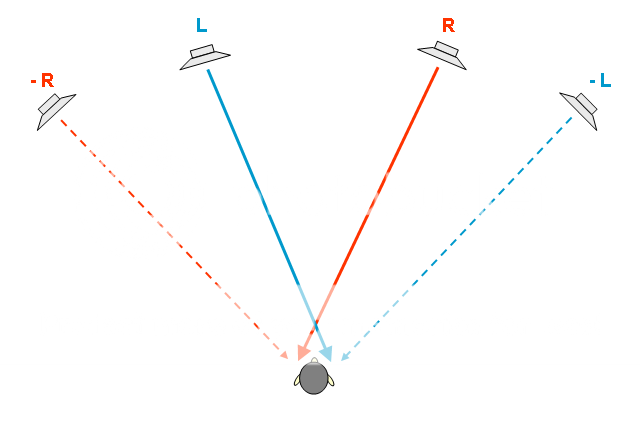
Now it's pure physical XTC.
Possible benefits:
- closer main pair provide better pinna cue, thus better central imaging
- stage width easily goes beyond main pair, even goes beyond outer pair
- images are very solid and 3D with depth, feel like they're properly shadowed, or feel like engraved
- 3D imaging bring some more impact and dynamics to the sound, overall a very vivid and lively presentation
Setting tips:
- the distance from the right ear to the inner L and outer R should be the same, vice versa
- setting with pink noise, pan the signal to one side, adjust the volume of outer channels, start from 0 until it's just detectable (they should be much quieter than the main channels)
- listening test with any recordings with good sound stage, usually a slightly higher volume on outer channels is allowed with music (compared to mono pink noise)
- you'll know when it's overdone, the violins appear on the right, or the likes, and smeared images.
- in a correct combination of distances and levels, there'd be a feel of well-focused
- feel free to experiment with the locations of speakers
- if no good things appears, something must be wrong in the polarity, maybe in amps, maybe in speakers
Any drawbacks? Sure, like anything else. Good effects only appear along the central line. Off by a short distance, they're gone. Fear not. It's not going to be worse than normal. I feel the imaging of off center listening is still better than plain stereo.
Oh, you need 2 pair of speakers and 2 sets of amps with individual volume control to play with this, of course.
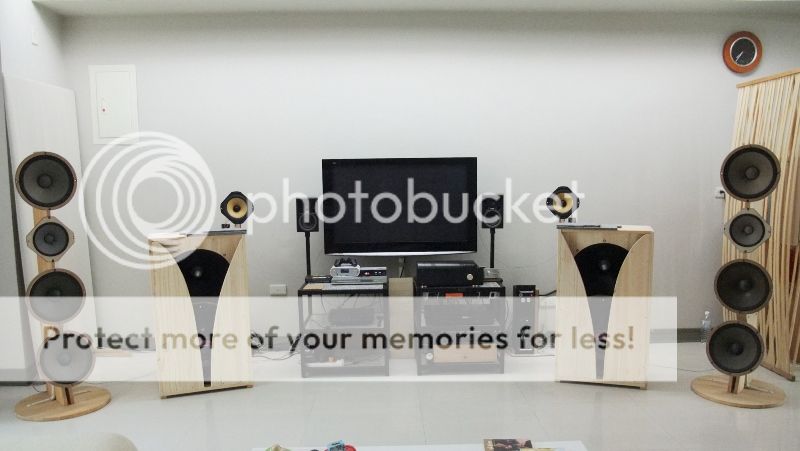
(Oops, there're 3 pairs of stereo. No, the small monitors by the TV are not in the system)
Have fun
This is actually a spinoff from this. It's already OT in that thread, so I think I'd better start a new one.
Many of you must have quite a few unused equipment collecting dust in the storage. Why not bring them back and have some fun?
In the link above, that is a '70 Hafler circuit. Outer channels play differential signals:

As can be seen, there's -R portion at the far L; -L portion at the far R. What's this? It's cross-talk cancellation !! Wow !
Also, there're (duplicated) R & L at the outside, which may expand the stage width (pro), but can also smear the images (con).
With the same physical layout and rewiring, they can do this:

Now it's pure physical XTC.
Possible benefits:
- closer main pair provide better pinna cue, thus better central imaging
- stage width easily goes beyond main pair, even goes beyond outer pair
- images are very solid and 3D with depth, feel like they're properly shadowed, or feel like engraved
- 3D imaging bring some more impact and dynamics to the sound, overall a very vivid and lively presentation
Setting tips:
- the distance from the right ear to the inner L and outer R should be the same, vice versa
- setting with pink noise, pan the signal to one side, adjust the volume of outer channels, start from 0 until it's just detectable (they should be much quieter than the main channels)
- listening test with any recordings with good sound stage, usually a slightly higher volume on outer channels is allowed with music (compared to mono pink noise)
- you'll know when it's overdone, the violins appear on the right, or the likes, and smeared images.
- in a correct combination of distances and levels, there'd be a feel of well-focused
- feel free to experiment with the locations of speakers
- if no good things appears, something must be wrong in the polarity, maybe in amps, maybe in speakers
Any drawbacks? Sure, like anything else. Good effects only appear along the central line. Off by a short distance, they're gone. Fear not. It's not going to be worse than normal. I feel the imaging of off center listening is still better than plain stereo.
Oh, you need 2 pair of speakers and 2 sets of amps with individual volume control to play with this, of course.

(Oops, there're 3 pairs of stereo. No, the small monitors by the TV are not in the system)
Have fun
A few observations:
-All four speakers should ideally have identical frequency response. In a real world, even if you use the same model speakers, the exact same frequency response can't be achieved from each position due to room effects.
-What is preventing the 'R-L' or '-L' signal being heard by the left ear, just as the 'R' signal is?
-Humans have two ears for a reason - we are very good at locating the direction of the source of the sound due to the difference in arrival times between each ear. Therefore we don't really hear 'crosstalk' as such, simply a difference in the location of the speakers. The aim for attempting this setup would seem to be to try to approach a speaker setup which mimics a headphone. In which case, why not just place the left speaker directly left of the listener and the right speaker directly right of the listener? It will achieve better rejection than this type of setup imho.
-All four speakers should ideally have identical frequency response. In a real world, even if you use the same model speakers, the exact same frequency response can't be achieved from each position due to room effects.
-What is preventing the 'R-L' or '-L' signal being heard by the left ear, just as the 'R' signal is?
-Humans have two ears for a reason - we are very good at locating the direction of the source of the sound due to the difference in arrival times between each ear. Therefore we don't really hear 'crosstalk' as such, simply a difference in the location of the speakers. The aim for attempting this setup would seem to be to try to approach a speaker setup which mimics a headphone. In which case, why not just place the left speaker directly left of the listener and the right speaker directly right of the listener? It will achieve better rejection than this type of setup imho.
Last edited:
I feel sorry that you missed the whole point and can't share the joy of this thing.
Just in case, maybe my writing is awful and hard to read, here are some highlight:
Oh, and this:
I should add: ... something must be wrong in the way of seeing the whole thing.
BTW, it's fine to pursue a perfect-everything audio system, or insist on staying with (plain) stereo in a mastering room. However, those are not in this topic.
Just in case, maybe my writing is awful and hard to read, here are some highlight:
Many of you must have quite a few unused equipment collecting dust in the storage. Why not bring them back and have some fun?
...
Any drawbacks? Sure, like anything else.
...
Have fun
Oh, and this:
...
- if no good things appears, something must be wrong in the polarity, maybe in amps, maybe in speakers
I should add: ... something must be wrong in the way of seeing the whole thing.
BTW, it's fine to pursue a perfect-everything audio system, or insist on staying with (plain) stereo in a mastering room. However, those are not in this topic.
I guess no one tried.
No problem, I still share what I've found.
Inspired by the paper:
http://www.princeton.edu/3D3A/Publications/BACCHPaperV4d.pdf
I added some LP filters into the recipe.
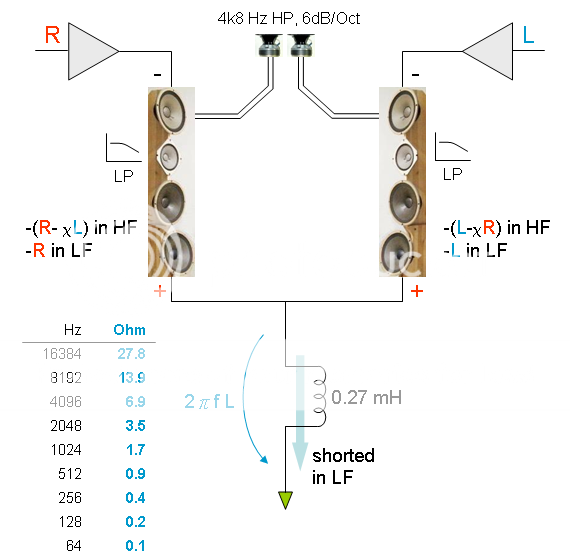
On the array itself, an LR contour filter gives it an overall downtilt response, with a slope slightly less than 1st order from ~200 Hz and up. (I'll keep fiddling with this later... )
This is for reducing the intended cancellation in HF.
Another LP element (a simple inductor) is added in the path of common ground of both speaker (and amp). The reactance of inductor makes a rising impedance with frequency. In LF, it's almost shorted, so both speakers play as usual. As the frequency rises, there'd be more and more differential portion ( L-xR / R-xL ). -- You may also refer to this for how it works.
Overall, it's doing XTC in LF and gradually turning into Hafler circuit (virtual ambio channels on the outside).
In the paper mentioned above, it says a perfect XTC is not linear (flat) in FR. It's more on LF. I think this makes sense, because the head of listener blocks the XT of HF above certain frequency anyway. So it's not necessary. OTOH, striving for perfect cancellation in HF is not practical. The wavelengths are so short and hard to be aligned perfectly, or the 'sweet' spot would get so small. (could be smaller than the head)
That's why, in the previous setting, the SPL of outer channel should be kept very low. Or the images change sides. With these LP filters, such effect is reduced. And the level can be raised somewhat, thus more cancellation.
The increased cancellation in LF brings more feel of envelopment & widening, without negative influence in central part. However, there's still a clear threshold. Once crossed, the images also change sides and there can even be some effect of 'double vision". Funny and messy.
Forgot to mention, the tweeters in the diagram above are put together at the center, against the wall to be as diffused as possible:
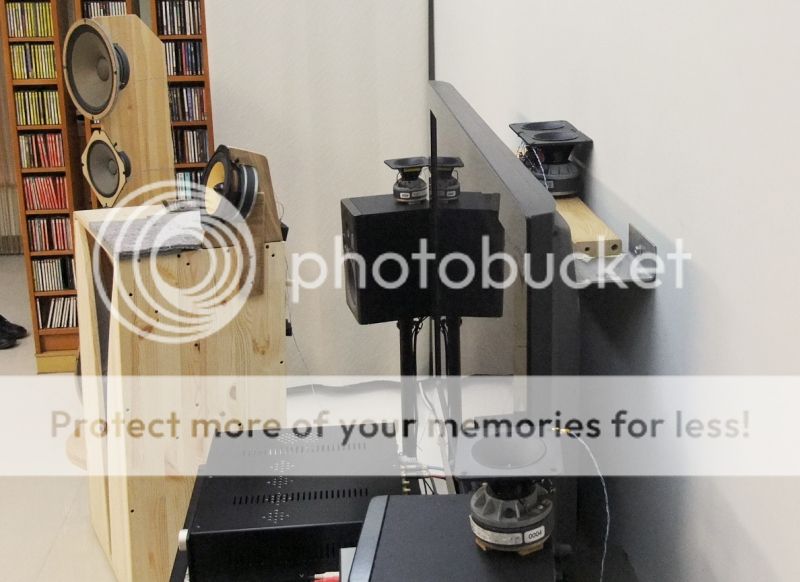
The two on both sides of TV are part of the main channels, support only the very top octave.
Some more good read:
The binaural performance of a cross-talk cancellation system with matched or mismatched setup and playback acoustics. - PubMed - NCBI
http://sound.media.mit.edu/Papers/gardner_thesis.pdf
No problem, I still share what I've found.
Inspired by the paper:
http://www.princeton.edu/3D3A/Publications/BACCHPaperV4d.pdf
I added some LP filters into the recipe.

On the array itself, an LR contour filter gives it an overall downtilt response, with a slope slightly less than 1st order from ~200 Hz and up. (I'll keep fiddling with this later... )
This is for reducing the intended cancellation in HF.
Another LP element (a simple inductor) is added in the path of common ground of both speaker (and amp). The reactance of inductor makes a rising impedance with frequency. In LF, it's almost shorted, so both speakers play as usual. As the frequency rises, there'd be more and more differential portion ( L-xR / R-xL ). -- You may also refer to this for how it works.
Overall, it's doing XTC in LF and gradually turning into Hafler circuit (virtual ambio channels on the outside).
In the paper mentioned above, it says a perfect XTC is not linear (flat) in FR. It's more on LF. I think this makes sense, because the head of listener blocks the XT of HF above certain frequency anyway. So it's not necessary. OTOH, striving for perfect cancellation in HF is not practical. The wavelengths are so short and hard to be aligned perfectly, or the 'sweet' spot would get so small. (could be smaller than the head)
That's why, in the previous setting, the SPL of outer channel should be kept very low. Or the images change sides. With these LP filters, such effect is reduced. And the level can be raised somewhat, thus more cancellation.
The increased cancellation in LF brings more feel of envelopment & widening, without negative influence in central part. However, there's still a clear threshold. Once crossed, the images also change sides and there can even be some effect of 'double vision". Funny and messy.
Forgot to mention, the tweeters in the diagram above are put together at the center, against the wall to be as diffused as possible:

The two on both sides of TV are part of the main channels, support only the very top octave.
Some more good read:
The binaural performance of a cross-talk cancellation system with matched or mismatched setup and playback acoustics. - PubMed - NCBI
http://sound.media.mit.edu/Papers/gardner_thesis.pdf
Last edited:
Hi there,
This is actually a spinoff from this. It's already OT in that thread, so I think I'd better start a new one.
Many of you must have quite a few unused equipment collecting dust in the storage. Why not bring them back and have some fun?
In the link above, that is a '70 Hafler circuit. Outer channels play differential signals:

As can be seen, there's -R portion at the far L; -L portion at the far R. What's this? It's cross-talk cancellation !! Wow !
Also, there're (duplicated) R & L at the outside, which may expand the stage width (pro), but can also smear the images (con).
With the same physical layout and rewiring, they can do this:

Now it's pure physical XTC.
Hi there,
Let's have a revisit to this. In post #299, there's a 4-ch proposal:
An externally hosted image should be here but it was not working when we last tested it.
I seems simple, just an ordinary stereo amp and 4 speakers without any fancy filter. Has anyone tried it?
Hi,
See post #300 http://www.diyaudio.com/forums/multi-way/36254-try-ambiophonics-your-speakers-6.html#post2166644 in the ambiophonics thread, for my interpretation of the concept
I believe it is primarly not for cross talk cancellation but for envelopement.
"55 degrees" is referred also in ambiophonics site as the optimum space angle for minimising IACC (inter aural cross correlation). Means maximising envelopement that way.
.
Thanks for the responses
@zelgall,
Sort of. What I hope for is actually reflection. The room is not symmetrical. It's much more open on the right side, so I need more reflection here. It's helpful in HF, to some extent.
Practically, I can't build a solid wall there, so here it is. It's just a sparse fence made in unfinished wood strips with minimal building effort. Those strips are not even fixed, staying in the frame just by their own resilience. There're additional two pieces of cardboards in the fence for more reflection, barely visible in the photo.
@Elias,
Finally, you came. (Where's graaf & other psychoacoustics guys?)
I wish I could. 180 degree positions are not allowed practically. Or I could have tried real OSD. Even if I can add delay to the elements on sides, the space is still not enough to place any physical speakers there. The only exception I can think of is DML on ceiling, but it's still difficult to get enough LF from available (allowable) dimensions.
Or I could have tried real OSD. Even if I can add delay to the elements on sides, the space is still not enough to place any physical speakers there. The only exception I can think of is DML on ceiling, but it's still difficult to get enough LF from available (allowable) dimensions.
The condition shown in the photo above is already the largest angle I can have. It's (only) +/- 40 some degree on the outer channels. Nevertheless, it feels very wide already in recordings of orchestra or chorus (or any other genres with wide soundstage). There's a sense of being at front row seat, facing a wide stage. Sometimes, it's even overly so...
TBH, I'm not quite sure about the XTC here, thus the conservative title, but I guess there's at least some effect of it, because it sounds different from Hafler circuit (R-L / L-R). The best part of it is not adding ambio/envelopment/widening, but a strong sense of well focused and sculpture-like imaging.
The latest setup is a mix -- opposite sides/polarity in LF, gradually turning into (some kind of) Hafler circuit as the frequency rises. The previous sculpture-like imaging seems diluted a bit, with some more envelopment. (makes sense, that's what the hardware is doing)
I'll do more listening and fiddling until I'm tired or enough...
Eventually, like many, I think I'll add a PC into the system, to play with all those DSP things. Maybe I'm old fashion, too slow in adopting new stuff.
Anyway, now I'm happy to put those extra speakers in interesting usage and have some fun along the process.
@zelgall,
Sort of. What I hope for is actually reflection. The room is not symmetrical. It's much more open on the right side, so I need more reflection here. It's helpful in HF, to some extent.
Practically, I can't build a solid wall there, so here it is. It's just a sparse fence made in unfinished wood strips with minimal building effort. Those strips are not even fixed, staying in the frame just by their own resilience. There're additional two pieces of cardboards in the fence for more reflection, barely visible in the photo.
@Elias,
Finally, you came. (Where's graaf & other psychoacoustics guys?)
I wish I could. 180 degree positions are not allowed practically.
The condition shown in the photo above is already the largest angle I can have. It's (only) +/- 40 some degree on the outer channels. Nevertheless, it feels very wide already in recordings of orchestra or chorus (or any other genres with wide soundstage). There's a sense of being at front row seat, facing a wide stage. Sometimes, it's even overly so...
TBH, I'm not quite sure about the XTC here, thus the conservative title, but I guess there's at least some effect of it, because it sounds different from Hafler circuit (R-L / L-R). The best part of it is not adding ambio/envelopment/widening, but a strong sense of well focused and sculpture-like imaging.
The latest setup is a mix -- opposite sides/polarity in LF, gradually turning into (some kind of) Hafler circuit as the frequency rises. The previous sculpture-like imaging seems diluted a bit, with some more envelopment. (makes sense, that's what the hardware is doing)
I'll do more listening and fiddling until I'm tired or enough...
Eventually, like many, I think I'll add a PC into the system, to play with all those DSP things. Maybe I'm old fashion, too slow in adopting new stuff.
Anyway, now I'm happy to put those extra speakers in interesting usage and have some fun along the process.
Where's graaf & other psychoacoustics guys?
yeah, good question
Hi there!
Interesting theme!
Since weeks I'm fiddeling arround with Ambiophonics and since a few days I'm with the MS-Stereo matrixing stuff.
IMHO yes, it is. But only half the way
Let me try to explain... Take your second picture. The -R is cancelling the R at the left ear (exact -180° at the left ear), but your right ear heares also the -R from the left side. This is what you talked abbout in post 8. Therefor only half way.
Now imagine your left speaker (L) is transparent to sound. Now you can place the -R speaker behind the L. The distance between them would be exact the same as before the diffence between L to left ear and -R to left ear (distace "-R" minus distance "L" [m] with regard to left ear). It is the runtime difference (delay) between your ears. At this point you have practically the same as in your setup (apart the small different pinna cues). The volume of the -R should be attenuated in same ammount as the R coming through the head shadow.
Now let's go a step ahead and look what to do to cancel the -R at the left ear. Right, you have to put a second R (R') behind the first R with two times the attenuation and to times the distance to R as the -R to the L. If you do this as often as the signal decraeses 60dB, you would have a room with nice "speaker trains" to your left and right. The left train is pointing directly to your left ear and vice versa.
Now lets spare some speakers (all but the L and R ) and do the delay, phase invert and attenuation in software.
) and do the delay, phase invert and attenuation in software.
And gues what?
THIS IS afaiu EXACTLY WHAT RACE DEOS!!!
In the RACE algorithm you can set mainly the both parameters: delay [µs] and attenuation. Delay is the distance between your speakers in your "speaker train" and attenuation afects the number of speakers in the train. RACE is an inverting echo train producer
The delay depends mainly of the angle between you speaker an the space between your ear canals. A good approximation is:
Time = sin (angle[°]/2) * ear canal distance [m] / speed of sound [m/s]
That means for typical stereo triangle of 60° and 15cm ear canal difference:
T= sin 30° * 0,15m / 343m/s = 218*10E-6s = 218µs
That would work, but only from low to low-mid frequncy because of artefacts (peaks and dips in FR). The RACE algorithem should be used with speaker angles between 20-30° (quote Glasgal) and then the times get lower:
Speaker 20°:
T= sin 10° * 0,15m / 343m/s = 76*10E-6s = 76µs
This works with only little artefacts up to arround 5kHz. Therefor the high pass filter in RACE algorithm.
The more you move the speaker together, the better the cancelling in HF. The wider the angle, the better the cancelling in LF.
Now in my head is the plan to do it n-way (like OSD, OpSoDis) with n different parameter sets. Maybe in combination with MS-Stereo .
.
The attenuation also depends on the angle, but also on your head shadow. In a perfect manner, the attenuation should be comply with your personal HRTF. But in RACE you can try the combination of attenuation an High Bypass.
A good starting point is 20°, 70µs, 2.3dB Att, 9kHz High Bypass and PEQ a mono pink noise to flat spectrum.
Sorry for OT regarding Ambiophonics.
I hope my writing is comprehensible...
cheers,
Mario
Interesting theme!
Since weeks I'm fiddeling arround with Ambiophonics and since a few days I'm with the MS-Stereo matrixing stuff.
What's this? It's cross-talk cancellation !! Wow !
Now it's pure physical XTC.
IMHO yes, it is. But only half the way
Let me try to explain... Take your second picture. The -R is cancelling the R at the left ear (exact -180° at the left ear), but your right ear heares also the -R from the left side. This is what you talked abbout in post 8. Therefor only half way.
Now imagine your left speaker (L) is transparent to sound. Now you can place the -R speaker behind the L. The distance between them would be exact the same as before the diffence between L to left ear and -R to left ear (distace "-R" minus distance "L" [m] with regard to left ear). It is the runtime difference (delay) between your ears. At this point you have practically the same as in your setup (apart the small different pinna cues). The volume of the -R should be attenuated in same ammount as the R coming through the head shadow.
Now let's go a step ahead and look what to do to cancel the -R at the left ear. Right, you have to put a second R (R') behind the first R with two times the attenuation and to times the distance to R as the -R to the L. If you do this as often as the signal decraeses 60dB, you would have a room with nice "speaker trains" to your left and right. The left train is pointing directly to your left ear and vice versa.
Now lets spare some speakers (all but the L and R
And gues what?
THIS IS afaiu EXACTLY WHAT RACE DEOS!!!
In the RACE algorithm you can set mainly the both parameters: delay [µs] and attenuation. Delay is the distance between your speakers in your "speaker train" and attenuation afects the number of speakers in the train. RACE is an inverting echo train producer
The delay depends mainly of the angle between you speaker an the space between your ear canals. A good approximation is:
Time
That means for typical stereo triangle of 60° and 15cm ear canal difference:
T= sin 30° * 0,15m / 343m/s = 218*10E-6s = 218µs
That would work, but only from low to low-mid frequncy because of artefacts (peaks and dips in FR). The RACE algorithem should be used with speaker angles between 20-30° (quote Glasgal) and then the times get lower:
Speaker 20°:
T= sin 10° * 0,15m / 343m/s = 76*10E-6s = 76µs
This works with only little artefacts up to arround 5kHz. Therefor the high pass filter in RACE algorithm.
The more you move the speaker together, the better the cancelling in HF. The wider the angle, the better the cancelling in LF.
Now in my head is the plan to do it n-way (like OSD, OpSoDis) with n different parameter sets. Maybe in combination with MS-Stereo
The attenuation also depends on the angle, but also on your head shadow. In a perfect manner, the attenuation should be comply with your personal HRTF. But in RACE you can try the combination of attenuation an High Bypass.
A good starting point is 20°, 70µs, 2.3dB Att, 9kHz High Bypass and PEQ a mono pink noise to flat spectrum.
Sorry for OT regarding Ambiophonics.
I hope my writing is comprehensible...
cheers,
Mario
Last edited:
Another old thread brought back to life. Or may this wasn't quite dead yet, like the old man in Holy Grail. 
Most of you in this thread will know about my crosstalk cancellation thread here:
Fixing the Stereo Phantom Center
Its purpose is tonal correction, not spacial. Probably has some of the same effects, tho.
If you look over in Wesayso's long thread about his line arays
The making of: The Two Towers (a 25 driver Full Range line array) See post starting around #4046.
You will see that he is using something similar to this XTC approach, but more complex. He has the ambient speakers off to the sides and a little behind (I think) and uses delay, reverb and the center signal mixed back in. The mains also get mid/side processing. He is very happy with the results.
If you use JRiver as your player and have a 4 channel sound card, the processing shown in the image attached below would give you the ambient channels needed for the set-up used in this thread. I put in some delay to play with, and a low pass filter as is often used in derived surround channels. Should be fun to play with and fairly flexible.
Most of you in this thread will know about my crosstalk cancellation thread here:
Fixing the Stereo Phantom Center
Its purpose is tonal correction, not spacial. Probably has some of the same effects, tho.
If you look over in Wesayso's long thread about his line arays
The making of: The Two Towers (a 25 driver Full Range line array) See post starting around #4046.
You will see that he is using something similar to this XTC approach, but more complex. He has the ambient speakers off to the sides and a little behind (I think) and uses delay, reverb and the center signal mixed back in. The mains also get mid/side processing. He is very happy with the results.
If you use JRiver as your player and have a 4 channel sound card, the processing shown in the image attached below would give you the ambient channels needed for the set-up used in this thread. I put in some delay to play with, and a low pass filter as is often used in derived surround channels. Should be fun to play with and fairly flexible.
Attachments
- Status
- This old topic is closed. If you want to reopen this topic, contact a moderator using the "Report Post" button.
- Home
- Loudspeakers
- Multi-Way
- 2 Pairs of Opposite Stereo (for a flavor of XTC)
